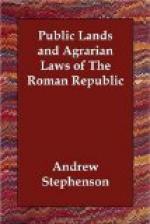-------+------- Total ...................|226,000 |141,250 Civic Colonies ..........| 38,900 | 30,500 |---------|------- Grand Total .............|264,900 |171,750 | | or | | 268.36 | |Sq. Mi. ---------------------------------------------------------+--
-------+-------
[Footnote 1: I have not here added Roman conquests outside of the peninsula of Italy, as these conquests were not treated as Roman territory until nearly a century later.]
SEC. 9.—LATIFUNDIA.
“After having pillaged the world as praetors or consuls during time of war, the nobles again pillaged their subjects as governors in time of peace;[1] and upon their return to Rome with immense riches they employed them in changing the modest heritage of their fathers into domains vast as provinces. In villas, which they were wont to surround with forests, lakes and mountains ... where formerly a hundred families lived at ease, a single one found itself restrained. In order to increase his park, the noble bought at a small price the farm of an old wounded soldier or peasant burdened with debt, who hastened to squander, in the taverns of Rome, the modicum of gold which he had received. Often he took the land without paying anything.[2] An ancient writer tells us of an unfortunate involved in a law suit with a rich man because the latter, discommoded by the bees of the poor man, his neighbor, had destroyed them. The poor man protested that he wished to depart and establish his swarms elsewhere, but that nowhere was he able to find a small field where he would not again have a rich man for a neighbor. The nabobs of the age, says Columella, had properties which they were unable to journey round on horseback in a day, and an inscription recently found at Viterba, shows that an aqueduct ten miles long did not traverse the lands of any new proprietors.... The small estate gradually disappeared from the soil of Italy, and with it the sturdy population of laborers.... Spurius Ligustinus, a centurian, after twenty-two campaigns, at the age of more than fifty years, did not have for himself, his wife, and eight children more than a jugerum of land and a cabin."[3]
To this masterly sketch quoted from Duruy, we can but add a few facts. Pliny affirms that under Nero only six men possessed the half of Africa.[4] Seneca, who himself possessed an immense fortune, says, concerning the rich men of his time, that they did not content themselves with possessing the lands that formerly had supported an entire people; they were wont to turn the course of rivers in order to conduct them through their possessions. They[5] desired even to embrace seas within their vast domains. We must here, it is true, make some allowance for rhetoric. So, too, in the writings of Petronius, some allowance for satire must be made, where he represents




